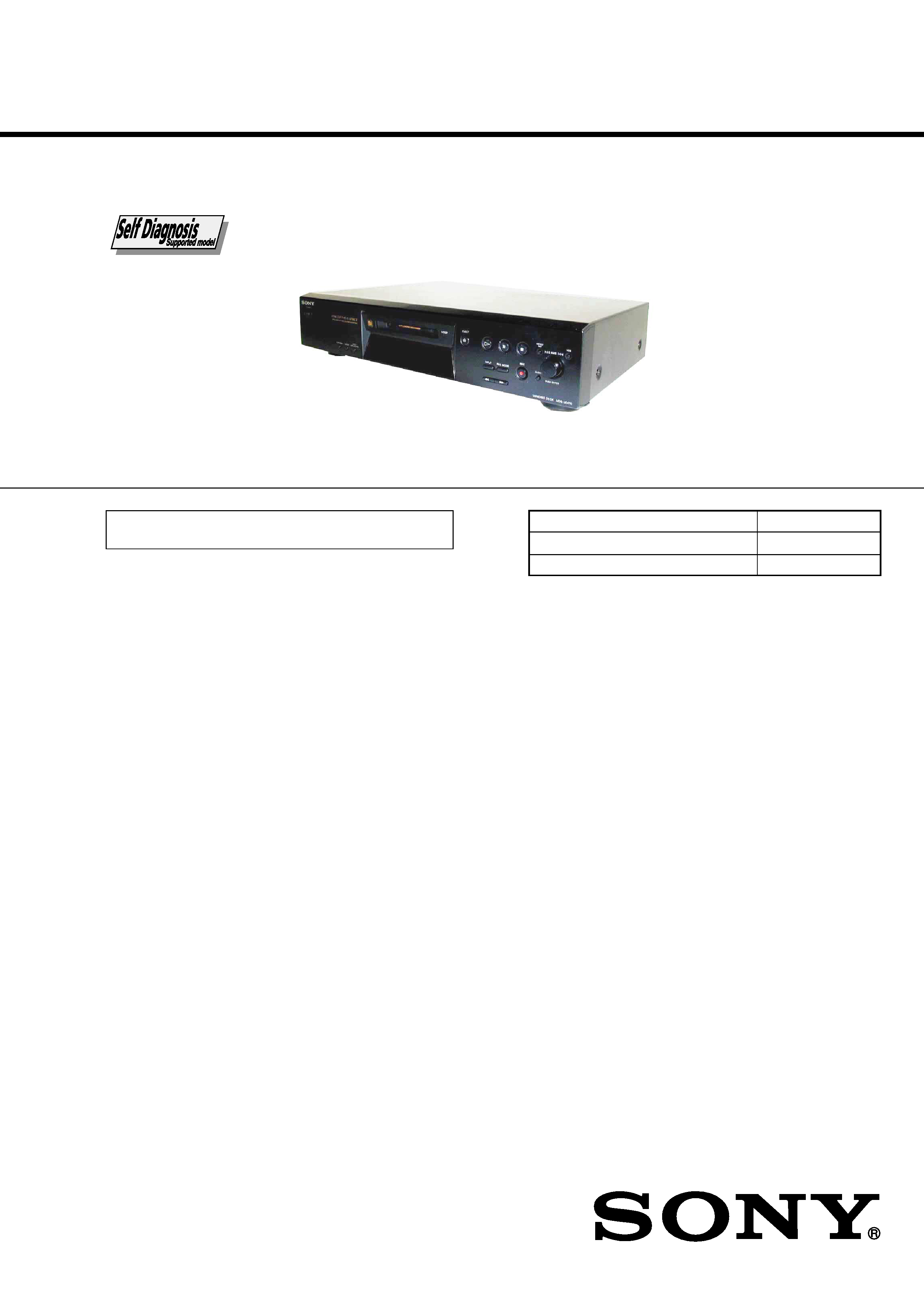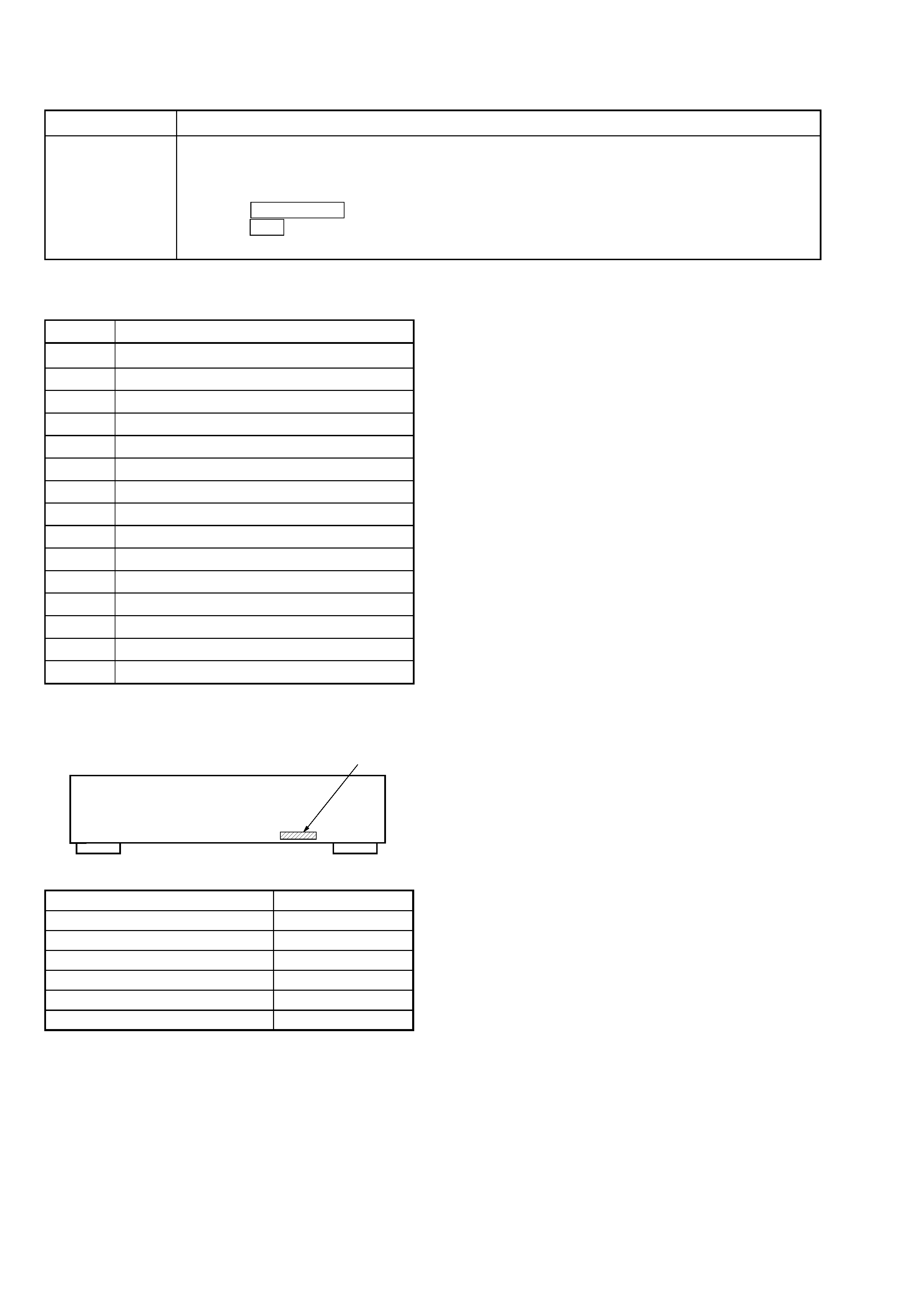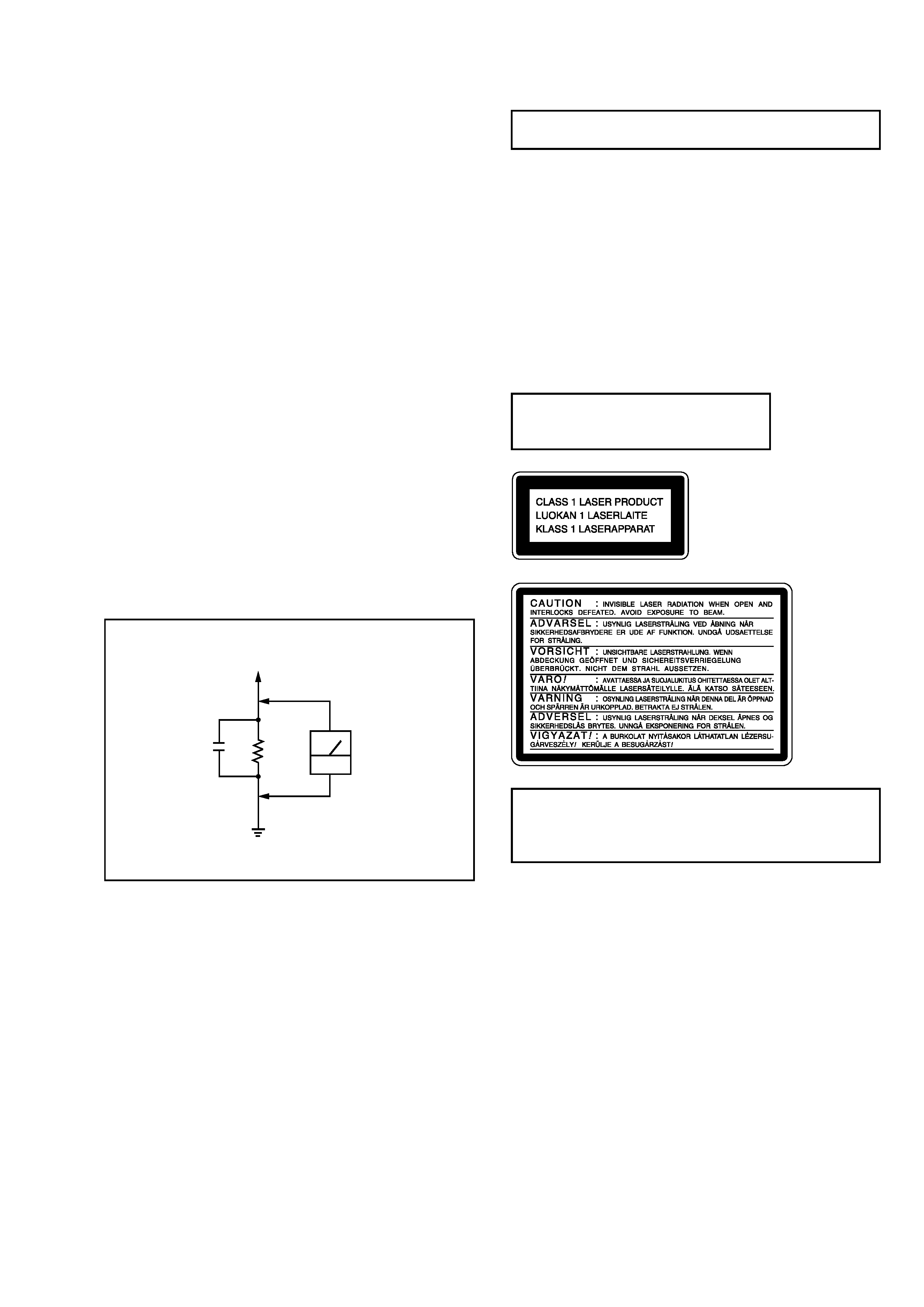
MDS-JE470
SPECIFICATIONS
SERVICE MANUAL
MINIDISC DECK
Model Name Using Similar Mechanism
MDS-S50
MD Mechanism Type
MDM-7A
Optical Pick-up Type
KMS-260B/260E
US Model
Canadian Model
AEP Model
UK Model
E Model
Australian Model
US and foreign patents licensed form Dolby Laboratories
Licensing Corporation.
System
MiniDisc digital audio
system
Disc
MiniDisc
Laser
Semiconductor laser
(
=780 nm) Emission
duration: continuous
Laser output
MAX 44.6
µW1)
1)
This output is the value measured at a distance of
200 mm from the objective lens surface on the
Optical Pick-up Block with 7 mm aperture.
Laser diode
Material: GaAlAs
Revolutions (CLV)
400 rpm to 900 rpm
Error correction
ACIRC (Advanced Cross
Interleave Reed Solomon
Code)
Sampling frequency
44.1 kHz
Coding
ATRAC (Adaptive
TRansform Acoustic
Coding)/ATRAC 3
Modulation system
EFM (Eight-to-Fourteen
Modulation)
Number of channels
2 stereo channels
Frequency response
5 to 20,000 Hz
±0.3 dB
Signal-to-noise ratio
Over 96 dB
during play
Wow and flutter
Below measurable limit
I nputs
ANALOG IN
Jack type: phono
Impedance: 47 kilohms
Rated input: 500 mVrms
Minimum input:
125 mVrms
DIGITAL OPTICAL IN
Connector type: square
optical
Impedance: 660 nm
(optical wave length)
Outputs
ANALOG OUT
Jack type: phono
Rated output: 2 Vrms (at
50 kilohms)
Load impedance: over
10 kilohms
-- Continued on next page --
Ver 1.0 2001. 05
9-873-891-11
2001E0200-1
© 2001.5
Sony Corporation
Home Audio Company
Shinagawa Tec Service Manual Production Group

2
MDS-JE470
SELF-DIAGNOSIS FUNCTION
The self-diagnosis function consists of error codes for customers which are displayed automatically when errors occur, and error codes which
show the error history in the test mode during servicing. For details on how to view error codes for the customer, refer to the following box
in the instruction manual. For details on how to check error codes during servicing, refer to the following "Procedure for using the Self-
Diagnosis Function (Error History Display Mode)".
Procedure for using the Self-Diagnosis Function (Error History Display Mode).
Note: Perform the self-diagnosis function in the "error history display mode" in the test mode. The following describes the least required
procedure. Be careful not to enter other modes by mistake. If you set other modes accidentally, press the MENU/NO button to exit
the mode.
Self-diagnosis function
The deck's self-diagnosis function automatically checks
the condition of the MD deck when an error occurs, then
issues a three- or five-digit code and an error message on
the display. If the code and message alternate, find them in
the following table and perform the indicated
countermeasure. Should the problem persist, consult your
nearest Sony dealer.
Three- or five-
digit code/
Message
Cause/Remedy
C11/Protected
The inserted MD is record-protected.
, Take out the MD and close the record-
protect slot.
C12/Cannot Copy
You tried to record a CD with a format
that the external device connected to the
deck does not support, such as CD-ROM
or video CD.
, Remove the disc and insert a music
CD.
C13/REC Error
The recording was not made properly.
, Set the deck in a stable surface, and
repeat the recording procedure.
The inserted MD is dirty (with smudges,
fingerprints, etc.), scratched, or
substandard in quality.
, Replace the disc and repeat the
recording procedure.
C13/Read Error
The deck could not read the TOC on the
MD properly.
, Take out the MD and insert it again.
C14/Toc Error
The deck could not read the TOC on the
MD properly.
, Insert another disc.
, If possible, erase all the tracks on the
MD .
C41/Cannot Copy
The sound source is a copy of
commercially available music software, or
you tried to record a CD-R (Recordable
CD).
, The Serial Copy Management System
prevents making a digital copy.
You cannot record a CD-R.
C71/Din Unlock
The sporadic appearance of this message
is caused by the digital signal being
recorded. This will not affect the
recording.
While recording from a digital component
connected through the DIGITAL IN
connector, the digital connecting cable
was unplugged or the digital component
turned off.
, Connect the cable or turn the digital
component back on.
E0001/
MEMORY NG
There is an error in the internal data that
the deck needs in order to operate.
, Consult your nearest Sony dealer.
E0101/
LASER NG
There is a problem with the optical
pickup.
, The optical pick-up may have failed.
Consult your nearest Sony dealer.
Three- or five-
digit code/
Message
Cause/Remedy
General
Power requirements
U.S.A. and Canadian models:
120 V AC, 60Hz
European model:
230 V AC, 50/60Hz
Australian model:
240 V AC, 50/60Hz
Hong Kong model:
220 240 V AC, 50/60Hz
Other models:
110 120/220 240 V
AC, 50/60Hz
Adjustable with voltage
selector
Power consumption
14 W (0.5 W in standby
mode)
Dimensions (approx.)
430 X 95 X285 mm
(w/h/d) incl. projecting
parts and controls
Mass (approx.)
3.0 kg
Supplied accessories
Audio connecting cords (2)
Optical cable (1)
Remote commander (remote) (1)
R6 (size-AA) batteries (2)
US and foreign patents licensed from Dolby
Laboratories.
Design and specifications are subject to change
without notice.

3
MDS-JE470
ITEMS OF ERROR HISTORY MODE ITEMS AND CONTENTS
Selecting the Test Mode
Display
op rec tm
op play tm
spdl rp tm
retry err
total err
err history
retry adrs
er refresh
tm change
op change
History
Displays the total recording time.
When the total recording time is more than 1 minute, displays the hour and minute
When less than 1 minute, displays "Under 1 min"
The display time is the time the laser is set to high power, which is about 1/4 of the actual recording time.
Displays the total playback time.
When the total playback time is more than 1 minute, displays the hour and minute
When less than 1 minute, displays "Under 1 min"
Displays the total rotating time of the spindle motor.
When the total rotating time is more than 1 minute, displays the hour and minute
When less than 1 minute, displays "Under 1 min"
Displays the total number of retry errors during recording and playback
Displays "r xx p yy". xx is the number of errors during recording. yy is the number of errors during playback.
This is displayed in hexadecimal from 00 to FF.
Displays the total number of errors
Displays "total xx". This is displayed in hexadecimal from 00 to FF.
Displays the past ten errors.
Displays "0x ErrCd@@".
X is the history number. The younger the number, the more recent is the history (00 is the latest). @@ is the error
code.
Select the error history number using the lAMSL knob.
Displays the past five retry addresses.
Displays "xx ADRS yyyy", xx is the history number, yyyy is the cluster with the retry error.
Select the error history number using the lAMSL knob.
Mode for erasing the error and retry address histories
Procedure
1. Press the lAMSL knob when displayed as "er refresh".
2. Press the YES button when the display changes to "er refresh?".
When "complete!" is displayed, it means erasure has completed.
Be sure to check the following after executing this mode.
*Data has been erased.
*Perform recording and playback, and check that the mechanism is normal.
Mode for erasing the total time of recording and playback
Procedure
1. Press the l
AMSL knob when displayed as "tm refresh".
2. Press the YES button when the display changes to "tm refresh?".
When "complete!" is displayed, it means erasure has completed.
Mode for erasing the total time of op rec tm, op play tm.
These histories are based on the time of replacement of the optical pickup. If the optical pick-up has been replaced,
perform this procedure and erase the history.
Procedure
1. Press the lAMSL knob when displayed as "op change".
2. Press the YES button when the display changes to "op change?".
When "Complete!" is displayed, it means erasure has completed.
1. While pressing the lAMSL knob and x button, connect the power plug to the outlet, and release the lAMSL knob and
x button.
When the test mode is set, "[Check]" will be displayed.
2. Rotate the lAMSL knob and when "[Service]" is displayed, press the YES button.
3. Rotate the lAMSL knob and display "Err Display".
4. Pressing the YES button sets the error history mode and displays "op rec tm".
5. Select the contents to be displayed or executed using the lAMSL knob.
6. Pressing the lAMSL knob will display or execute the contents selected.
7. Pressing the lAMSL knob another time returns to step 4.
8. Pressing the MENU/NO button displays "Err Display" and exits the error history mode.
9. To exit the test mode, press the REPEAT button. The unit sets into the STANDBY state, the disc is ejected, and the test mode ends.

4
MDS-JE470
Description
Table of Error Codes
Error Code
10
12
20
21
22
23
24
30
31
40
41
42
43
50
51
Could not load
Loading switches combined incorrectly
Timed out without reading the top of PTOC
Could read top of PTOC, but detected error
Timed out without accessing UTOC
Timed out without reading UTOC
Error in UTOC
Could not start playback
Error in sector
Retry cause generated during normal recording
Retried in DRAM overflow
Retry occurred during TOC writing
Retry aborted during S.F editing
Other than access processing, and could not read address.
Focus NG occurred and overran.
MODEL IDENTIFICATION
-- BACK PANEL --
Part No.
· Abbreviation
CND : Canadian model
SP
: Singapore model
HK
: Hong Kong model
AUS
: Australian model
MODEL
AEP, UK models
US model
CND model
SP models
HK model
AUS model
PARTS No.
4-233-025-0s
4-233-025-1s
4-233-025-2s
4-233-025-3s
4-233-025-4s
4-233-025-5s
Display
History
spdl change
Mode for erasing the total spdl rp tm time
These histories are based on the time of replacement of the spindle motor. If the spindle motor has been replaced,
perform this procedure and erase the history.
Procedure
1. Press the lAMSL knob when displayed as "spdl change"
2. Press the YES button when the display changes to "spdl change?"
When "Complete!" is displayed, it means erasure has completed.
TABLE OF CONTENTS
1. SERVICING NOTES ........................................................ 5
2. GENERAL ........................................................................ 12
3. DISASSEMBLY
3-1. Disassembly flow .............................................................. 13
3-2. Upper Case (408226) ........................................................ 14
3-3. Front Panel Section ........................................................... 14
3-4. Main Board ....................................................................... 15
3-5. PT Board, VOL-SEL Board (SP model) ........................... 15
3-6. Mechanism Deck Section ( MDM-7A) ............................. 16
3-7. Over Light Head (HR901), BD Board .............................. 16
3-8. Holder Assy ....................................................................... 17
3-9. Loading Motor Assy (M103) ............................................ 17
3-10. Sled Motor Assy (M102), Slider ....................................... 18
3-11. Optical Pick-up .................................................................. 18
3-12. Spindle Moter Assy (M101) .............................................. 19
4. TEST MODE ......................................................................20
5. ELECTRICAL ADJUSTMENTS ............................... 25
6. DIAGRAMS
6-1. Circuit Boards Location ...................................................... 36
6-2. Block Diagrams
· BD Section ....................................................................... 38
· Main Section .................................................................... 39
6-3. Printed Wiring Board BD Board ................................... 40
6-4. Schematic Diagram BD Section (1/2) ........................... 41
6-5. Schematic Diagram BD Section (2/2) ........................... 42
6-6. Schematic Diagram Main Section (1/2) ........................ 43
6-7. Schematic Diagram Main Section (2/2) ........................ 44
6-8. Printed Wiring Board Main Section ............................. 45
6-9. Printed Wiring Board Display Section .......................... 46
6-10. Schematic Diagram Display Section .......................... 47
6-11. Printed Wiring Board Power Section ......................... 48
6-12. Schematic Diagram Power Section ............................ 49
6-13. IC Block Diagrams ........................................................... 50
6-14. IC Pin Functions ............................................................... 52
7. EXPLODED VIEWS
7-1. Chassis Section ................................................................... 59
7-2. Front Panel Section ............................................................. 60
7-3. Mechanism Section-1 (MDM-7A) ...................................... 61
7-4. Mechanism Section-2 (MDM-7A) ...................................... 62
8. ELECTRICAL PARTS LIST ........................................ 63

5
MDS-JE470
SECTION 1
SERVICE NOTES
This appliance is classified as a
CLASS 1 LASER product. The
CLASS 1 LASER PRODUCT
MARKING is located on the
rear exterior.
Laser component in this product is capable
of emitting radiation exceeding the limit for
Class 1.
CAUTION
Use of controls or adjustments or performance of procedures
other than those specified herein may result in hazardous radia-
tion exposure.
Notes on chip component replacement
· Never reuse a disconnected chip component.
· Notice that the minus side of a tantalum capacitor may be
damaged by heat.
Flexible Circuit Board Repairing
· Keep the temperature of soldering iron around 270°C
during repairing.
· Do not touch the soldering iron on the same conductor of the
circuit board (within 3 times).
· Be careful not to apply force on the conductor when soldering
or unsoldering.
NOTES ON HANDLING THE OPTICAL PICK-UP
BLOCK OR BASE UNIT
The laser diode in the optical pick-up block may suffer electrostatic
break-down because of the potential difference generated by the
charged electrostatic load, etc. on clothing and the human body.
During repair, pay attention to electrostatic break-down and also
use the procedure in the printed matter which is included in the
repair parts.
The flexible board is easily damaged and should be handled with
care.
NOTES ON LASER DIODE EMISSION CHECK
Never look into the laser diode emission from right above when
checking it for adjustment. It is feared that you will lose your sight.
SAFETY-RELATED COMPONENT WARNING!!
COMPONENTS IDENTIFIED BY MARK 0 OR DOTTED LINE WITH
MARK 0 ON THE SCHEMATIC DIAGRAMS AND IN THE PARTS
LIST ARE CRITICAL TO SAFE OPERATION. REPLACE THESE
COMPONENTS WITH SONY PARTS WHOSE PART NUMBERS
APPEAR AS SHOWN IN THIS MANUAL OR IN SUPPLEMENTS
PUBLISHED BY SONY.
ATTENTION AU COMPOSANT AYANT RAPPORT
À LA SÉCURITÉ!
LES COMPOSANTS IDENTIFÉS PAR UNE MARQUE 0 SUR LES
DIAGRAMMES SCHÉMATIQUES ET LA LISTE DES PIÈCES SONT
CRITIQUES POUR LA SÉCURITÉ DE FONCTIONNEMENT. NE
REMPLACER CES COMPOSANTS QUE PAR DES PIÈSES SONY
DONT LES NUMÉROS SONT DONNÉS DANS CE MANUEL OU
DANS LES SUPPÉMENTS PUBLIÉS PAR SONY.
This caution
label is located
inside the unit.
SAFETY CHECK-OUT
(US model only)
After correcting the original service problem, perform the fol-
lowing safety checks before releasing the set to the customer:
Check the antenna terminals, metal trim, "metallized" knobs, screws,
and all other exposed metal parts for AC leakage. Check leakage as
described below.
LEAKAGE
The AC leakage from any exposed metal part to earth ground and
from all exposed metal parts to any exposed metal part having a
return to chassis, must not exceed 0.5 mA (500 microampers). Leak-
age current can be measured by any one of three methods.
1. A commercial leakage tester, such as the Simpson 229 or RCA
WT-540A. Follow the manufacturers' instructions to use these
instruments.
2. A battery-operated AC milliammeter. The Data Precision 245
digital multimeter is suitable for this job.
3. Measuring the voltage drop across a resistor by means of a VOM
or battery-operated AC voltmeter. The "limit" indication is 0.75
V, so analog meters must have an accurate low-voltage scale.
The Simpson 250 and Sanwa SH-63Trd are examples of a pas-
sive VOM that is suitable. Nearly all battery operated digital
multimeters that have a 2V AC range are suitable. (See Fig. A)
Fig. A. Using an AC voltmeter to check AC leakage.
0.15
µF
To Exposed Metal
Parts on Set
1.5k
AC
voltmeter
(0.75V)
Earth Ground
